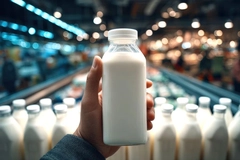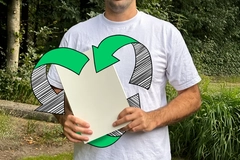Plastic use can be halved without compromising fruit and veg shelf life, finds Canadian study

27 Aug 2024 --- A new study commissioned by Agriculture and Agri-Food Canada (AAFC) and Environment and Climate Change Canada (ECCC) has underscored the role of plastic packaging in fresh produce supply chains while identifying opportunities to reduce its use “without compromising key outcomes.”
The research suggests that it is possible to reduce the plastic packaging of fruits and vegetables in Canadian retail stores by half without causing significant negative consequences.
In response to these findings, the Canadian Produce Marketing Association (CPMA) cautions that reducing packaging waste “must not come at the expense of other sustainability goals, such as food safety, waste prevention and the maintenance of sustainable supply chains.”
“CPMA is pleased to see the Government of Canada commission an industry-informed study which highlights the critical role and function that fresh produce packaging plays to ensure that high-quality fruits and vegetables are available to Canadians year-round,” says Ron Lemaire, president at CPMA.
“Consumers are requesting safe, affordable and high-quality fresh produce which is only available when respective supply chains — and the critical packaging forms they rely upon — are readily accessible.”
Gradual reductions
The study, titled “Quantifying the Functionality Importance of Plastic Packaging in Fresh Produce from a Needs/Benefit Perspective,” offers a comprehensive analysis of the functionality that plastic packaging provides, including protection, containment and communication, all of which are critical for ensuring the safety, quality and availability of fresh produce.
According to the study, “feasible reductions” of plastic can be made in packaging systems for harder produce, like apples and onions, where plastic is often used for cost or efficiency reasons.
Transitioning to alternatives like cardboard trays and perforated paper overlays or selling produce loose could be viable, but the shift must be gradual, with pilot programs to assess impacts and ensure consumer acceptance.
The report emphasizes the protective role of packaging, noting how plastic helps preserve produce, prevent contamination and maintain microbial control. It also notes that its projections need to account for future packaging innovations that could further reduce the need for plastic packaging.
Recent advances in this space include Saveggy’s edible coating that increases the shelf life of fresh fruits and vegetables. The solution is a thin protective layer based on plant sources such as canola and oats, which prevents moisture loss, while slowing down oxidation to help retain the product’s firmness and visual appeal.
Meanwhile, Italian company Qwarzo uses silicon dioxide, linked to cellulose fibers, as a replacement for materials like PFAS. Qwarzo’s barrier solution turns paper or cardboard hydrophobic, which can be used to pack foodstuffs.
Impact and response
Last December, the CPMA, along with produce industry stakeholders and partner associations, conducted extensive research to assess and communicate the negative impacts of the proposed Pollution Prevention Plan Notice for Primary Food Packaging on Canadians and the fresh produce sector.
The notice required Canada’s largest grocery retailers to prepare and implement a pollution prevention plan to meet targets to reduce, reuse and redesign primary food plastic packaging.
The CPMA underscores that the newly commissioned study supports many of the points raised in its regulatory impact studies. While it doesn’t address fresh produce affordability, the study does cover nearly 95% of fresh produce sold by volume.
.jpg) Two scenarios from the report are achievable within realistic timeframes, provided that changes are made in a deliberate and measured way.The study findings support the CPMA and Western Growers in their efforts to develop sustainable produce packaging guidelines.
Two scenarios from the report are achievable within realistic timeframes, provided that changes are made in a deliberate and measured way.The study findings support the CPMA and Western Growers in their efforts to develop sustainable produce packaging guidelines.
Daniel Duguay, Sustainability Specialist at CPMA, tells Packaging Insights: “The primary challenge in developing sustainable produce packaging guidelines is accounting for the variability in end-of-life waste management practices across multiple markets and jurisdictions. Currently, recycling capabilities vary significantly by state and province, if not from city to city.”
“Furthermore, other waste management capabilities such as composting or reuse are either totally absent or being considered in many key markets. As such, packaging guidelines will be developed which reinforce the critical functionality produce packaging provides — while accounting for the varying nature of waste management infrastructure. The absence of waste management infrastructure should not justify the elimination or constraints that hinder the sustainability of fresh produce supply chains.”
Duguay suggests that the industry can address potential trade-offs between reducing packaging waste and maintaining its critical functionality by taking an approach that recognizes that reducing waste is just one of many important goals in packaging decisions.
The CPMA has introduced a guide that offers a comprehensive framework for making packaging decisions, focusing on key factors that are essential for sustainable packaging. “These include produce availability, minimizing food loss, ensuring food safety, clear labeling, as well as environmental outcomes such as minimizing the supply chain carbon footprint as well as minimizing packaging waste and pollution.”
“The current focus on packaging waste, or to be more precise the elimination of plastic — to the detriment of the other packaging outcomes — reflects the need to adopt a more holistic approach to packaging decision making, ” highlights Duguay.
This year, a study commissioned by the International Council of Chemical Associations and conducted by Oxford Economics analyzed the socioeconomic and environmental impacts of capping virgin plastics production. It found that supply limit policies would impact the entire plastics value chain, emphasizing that developed nations like Canada are expected to see a decline in their share of global plastic consumption over the next decade.
Canada’s target to achieve its goal of zero plastic waste by 2030 is propelling the transformative shift toward more sustainable packaging solutions. The Canadian government has been collaborating with all levels of government, industry, NGOs, researchers and citizens on this issue.
By Sichong Wang











